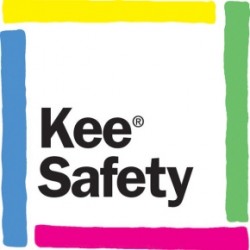
Kee Gate complies with latest revised BSI Standard for safety gates
Kee Safety has adjusted the design of its Kee Gate range to satisfy the latest requirements of BS EN ISO 14122-3:2016 Safety of Machinery – Permanent means of access to machinery – Part 3: Stairs, Stepladders and guard-rails.
Kee Gate meets revised BSI Standard for saftey gates
 The new Kee Gate range, from Kee Safety, a leading supplier of safety railing systems, retains key elements of the existing safety gates, but has been modified to meet the BSI Standard.
The new Kee Gate range, from Kee Safety, a leading supplier of safety railing systems, retains key elements of the existing safety gates, but has been modified to meet the BSI Standard.
Released in 2016, the revised standard defines the requirements for safe access to machines. It applies to both stationary and mobile machinery where a fixed means of access is necessary.
The BSI standard specifies that when the height of a fall could exceed 500mm, a guardrail should be installed, and the chosen system needs to meet several dimensional requirements. It also notes that a self-closing gate should be used.
The revised standard states that the gap between both railings and the floor must not exceed 500mm. To remain compliant with this standard, Kee Safety has had to modify the design of its safety gates.
Kee Gate design modifications
The Kee Gate design now features a larger D bend, which closes the gap between the bottom rail of the gate and floor, whilst still allowing full width adjustability along with a new mid rail which closes the gap between the top of the gate and the mid rail. The new gate is 668mm high, its mid rail is positioned 467mm from the top rail and a lower bottom rail is positioned 433mm from the floor. These modifications ensure that the Kee Gate range is compliant with the revised BSI standard.
As well as being compliant to BS EN ISO 14122-3:2016, Kee Gate also complies with the requirements of EN 13374 Class A, and is CE marked to EN 1090. The system has undergone extensive testing to ensure total reliability of the gates. These include salt spray testing to ASTM B117-11 Neutral solutions over 200 hours to assess the coating’s corrosion resistance, life cycle testing to BS 6375-2:2009 Clause 6.5 – Opening and closing of Gate through 90 degrees 50,000 cycles and Abuse Testing where 9 x 25kg weights were suspended from the gate to test what happens if pressure is applied. This ensures durability, superior corrosion resistance and defence against signs of wear.
Preferred safety gates solution
Designed to work both internally and externally, on ladder and stair access points, roof hatches, walkways and roof tops, Kee Gate, ensures maintenance, inspection and warehouse staff can fulfil their job, follow best practices and comply with current safety standards, without putting their safety at risk. Kee Gate safety gates are spring loaded so can automatically close behind the user, providing an added level of security and overcoming the potential for human error. This type of system is the preferred solution to chains, bars or sliding tubes, as these traditional forms of protection can lead to a hazardous void, when used incorrectly.
Kee Safety gates range
The Kee Gate range is available in galvanised steel and if required can be powder coated in safety yellow. It is available with standard ‘U’ bolts for fixing to uprights of 33.7, 42.4 and 48.3 mm diameter, enabling the gate to be fixed quickly to existing support structures, posts or stringers.
An additional fixing pack is provided which allows the gate to be fixed to square, flat or angle uprights. Kee Gate is 1 metre wide and is designed to be trimmed on-site, saving companies the time and money it takes to fabricate their own gates.
Kee Safety
Cradley Business Park Overend Road
Cradley Heath
West Midlands
B64 7DW
UK
+44 (0) 1384 632 188
44 (0) 1384 632 192
Visit Supplier's page
Latest news

29th April 2025
CPD Courses Available Online From Ecological Building Systems
Ecological Building Systems, a leading supplier of natural building products for sustainable construction, has revealed its comprehensive CPD programme for the year ahead.
Posted in Articles, Building Industry Events, Building Industry News, Building Products & Structures, Building Services, Continuing Professional Development (CPD's), Information Technology, Innovations & New Products, Insulation, Restoration & Refurbishment, Retrofit & Renovation, Seminars, Sustainability & Energy Efficiency, Training, Walls, Waste Management & Recycling
29th April 2025
WindowBASE launches new prospect databases at FIT Show
Visit WindowBASE at the FIT Show to see first-hand how it helps companies find new customers – the company is launching an easy-to-use, intuitive platform on Stand G16 at the NEC Birmingham from 29th April – 1st May.
Posted in Articles, Building Industry Events, Building Industry News, Building Products & Structures, Building Services, Doors, Exhibitions and Conferences, Glass, Glazing, Information Technology, Innovations & New Products, Posts, Publications, Research & Materials Testing, Restoration & Refurbishment, Retrofit & Renovation, Windows
28th April 2025
Nuaire first UK ventilation manufacturer to use low carbon-emissions recycled & renewably produced steel
Nuaire has announced that its Magnelis® steel based ventilations systems are now being made from XCarb® recycled and renewably produced steel.
Posted in Air Conditioning, Articles, Building Industry News, Building Products & Structures, Building Services, Building Systems, Heating, Ventilation and Air Conditioning - HVAC, Restoration & Refurbishment, Retrofit & Renovation, Steel and Structural Frames, Sustainability & Energy Efficiency, Waste Management & Recycling
28th April 2025
Renderplas: Builders avoid costly remedial work with PVCu render beads
A pioneer of PVCu render beads, Renderplas is helping the construction industry avoid the costly remedial work associated with rusting steel designs…
Posted in Articles, Building Industry News, Building Products & Structures, Building Services, Building Systems, Facades, Posts, Render, Restoration & Refurbishment, Retrofit & Renovation, Sustainability & Energy Efficiency, Walls
 Sign up:
Sign up: